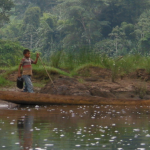One Community’s Water
Two machete-wielding community members lead the way. Two more position themselves in the back. The route between San Andres and the community’s water source starts at the edge of the riverbank community, beyond the scattering of stick-built homes and into the thick of the forested Indigenous territory. We navigate muddy ascents, through jungle overgrowth, across fallen fruits on the forest floor, under and over downed trees, altogether feeling small swathed in the green walls that surround us as we make our way to the source of the stream we loosely follow.
While much of the pipe that connects the water source to the community’s water tank has been buried (a feat that is difficult to comprehend considering the landscape), lengths of pipe, all but camouflaged by the lush surroundings, also run above ground, supported in some places by moss-covered concrete bases and in others by the crook of a well-placed tree branch.

We pass broken valves and vents, and in more than one particularly vulnerable section, repairs are obvious. Alternating red plastic wrap and a woven textile provide a strategic cummerbund around the pipe’s circumference – an attempt to stop the bleeding caused by Hurricane Iota’s wrath two years ago. Strands of metal wires slung around the pipe and a nearby low-hanging branch twist together to provide a makeshift supplemental sling support.
For all the lack of resources, there is no lack of resourcefulness here.

Upon arrival at the source, the team collects samples and performs water quality tests. The results of which will be read in time. We head back. Again, we follow the leader. We listen for monkeys. We chew on sugar cane. We soak in the stories of the seemingly fearless – stories of fights witnessed between yellow beard snakes and anacondas, stories of heroic boar hunts, stories of wild adventures in the wild. And we all laugh.
But, the laughing is short-lived.
While the tests for heavy metal contamination of the water source come back clear, tests for bacterial contamination are less so. A subsequent visit to the community water tank reveals that it is in disrepair. The water supply reaching the community is limited by its performance.

In short, at the other end of the water system – the homes of the families who live here – sometimes there is water, sometimes there is not. And when there is water, consumption without consequence is a gamble.
But, there is also a good news story.
The water source here is healthy. With sustainable water management practices, community engagement, and building the capacity of the water board, overcoming the bad news is possible! Installation of and continuous management of a chlorinator will make the water safe to drink, and repairs to the tank and pipe and valves will make the system less vulnerable while restoring the flow of water to families – water that is safe to drink.

Reaching the goal of safe sustainable water systems in ten communities in the Bosawás begins with just this one. With your help.
Your generous support of our spring campaign brings communities in the Bosawás #WITHINREACH of EOS support and brings clean water within reach for the people of the Bosawás.






